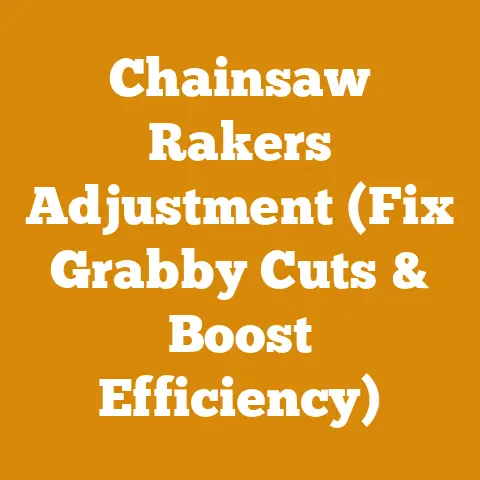Vibration Resistant Gloves for Woodworkers (5 Proven Comfort Tips)
Do you ever feel that tingling numbness in your hands after a long day of woodworking? Or maybe that persistent ache that just won’t go away? If you’re nodding along, you’re not alone. Vibration is a silent enemy for us woodworkers, and it can lead to some serious long-term health problems. That’s why I’m diving deep into vibration-resistant gloves. I’m going to share five proven comfort tips that will help you protect your hands and keep you working comfortably for years to come.
Why Vibration Matters: My Personal Wake-Up Call
I’ve been around wood my whole life. My grandfather was a logger, my father a carpenter, and I followed in their footsteps, eventually running my own small firewood business. For years, I shrugged off the hand fatigue and occasional numbness as just “part of the job.” I thought I was as tough as the oak I was splitting.
Then, about five years ago, the numbness started becoming more frequent and more intense. Simple tasks like buttoning my shirt became difficult. My doctor diagnosed me with Hand-Arm Vibration Syndrome (HAVS), a condition caused by prolonged exposure to vibration. It was a wake-up call. I realized I needed to take vibration seriously.
That’s when I started researching and experimenting with different types of vibration-resistant gloves. I learned a lot through trial and error, and I’m here to share what I’ve discovered so you don’t have to make the same mistakes I did.
Understanding the Enemy: Hand-Arm Vibration Syndrome (HAVS)
Before we get into the gloves themselves, let’s understand what we’re fighting against. HAVS, also known as vibration white finger, is a serious condition that affects the blood vessels, nerves, and joints of the hand, wrist, and arm. It’s caused by prolonged exposure to vibration, typically from power tools like chainsaws, grinders, and impact wrenches.
Here’s a breakdown of the key symptoms:
- Numbness and tingling: Often the first sign. It usually starts in the fingertips and can spread to the entire hand.
- Blanching (whitening) of the fingers: This is caused by reduced blood flow and is often triggered by cold temperatures.
- Pain and aching: Can range from mild discomfort to severe, debilitating pain.
- Loss of grip strength: Makes it difficult to hold tools or perform fine motor tasks.
The Statistics Are Sobering:
According to the National Institute for Occupational Safety and Health (NIOSH), an estimated 1.2 million workers in the United States are exposed to hand-arm vibration on the job. Studies have shown that up to 50% of these workers may develop HAVS over time. The risk is even higher for those who work with vibrating tools for extended periods or who have other pre-existing conditions.
Why is this important? Because HAVS is often irreversible. Once the damage is done, it can be difficult to treat, and it can significantly impact your quality of life. Prevention is key, and that’s where vibration-resistant gloves come in.
The Five Proven Comfort Tips for Vibration-Resistant Gloves
Now that we understand the risks, let’s get to the good stuff: how to choose and use vibration-resistant gloves to protect your hands. Here are my five proven comfort tips, based on my own experiences and research.
Tip 1: Know Your Vibration Frequency: The Glove’s Achilles Heel
Not all vibration is created equal. Different tools produce different frequencies of vibration. High-frequency vibration (like from a grinder) feels different than low-frequency vibration (like from a chainsaw). And guess what? Gloves are designed to dampen specific frequency ranges.
Understanding Frequency:
- Frequency is measured in Hertz (Hz), which represents the number of cycles per second.
- Low-frequency vibration (below 200 Hz) is often associated with larger, heavier tools like chainsaws and jackhammers.
- High-frequency vibration (above 200 Hz) is common with smaller, faster tools like grinders and sanders.
Why It Matters:
A glove designed for high-frequency vibration might not be effective at dampening low-frequency vibration, and vice versa. Using the wrong glove can actually amplify the vibration, making the problem worse.
How to Find the Right Glove:
- Check the Tool’s Specifications: Most tool manufacturers will list the vibration frequency of their tools in the user manual or on the tool itself. Look for a value in meters per second squared (m/s²).
- Read the Glove’s Label: Look for gloves that are specifically designed for the frequency range of your tools. The label should indicate the vibration reduction performance in terms of frequency. Look for standards like EN ISO 10819, which tests gloves for vibration reduction.
- Consider the Material: Different materials dampen different frequencies. Gel-padded gloves are generally better for high-frequency vibration, while foam-padded gloves are often better for low-frequency vibration.
My Experience:
I made the mistake of using a general-purpose anti-vibration glove with my chainsaw for years. I thought I was protected, but I wasn’t paying attention to the frequency. Once I switched to a glove specifically designed for low-frequency vibration, I noticed a significant difference in the amount of vibration I felt. It was like night and day.
A glove that’s too tight will restrict blood flow, making your hands more susceptible to vibration-induced injuries. A glove that’s too loose won’t provide adequate protection, and it can also be dangerous if it interferes with your grip.
The Goldilocks Principle:
You need a glove that’s just right. Not too tight, not too loose, but perfectly snug.
How to Achieve the Perfect Fit:
- Measure Your Hand: Use a tape measure to determine the circumference of your hand at the widest point (usually around the knuckles). Consult the glove manufacturer’s sizing chart to find the corresponding glove size.
- Try Before You Buy: If possible, try on gloves before you buy them. Make sure you can comfortably grip a tool without the glove feeling too tight or too loose.
- Consider the Task: If you’re doing fine motor tasks, you’ll need a glove that allows for good dexterity. If you’re doing heavy-duty work, you’ll need a glove that provides more protection.
- Check the Closure: Make sure the glove has a secure closure that prevents it from slipping off during use. Velcro straps or adjustable cuffs are good options.
My Experience:
I used to buy gloves that were a size too large because I thought they would be more comfortable. But I quickly realized that loose gloves were actually more tiring to wear because I had to grip the tool harder to compensate for the lack of control. Once I started wearing gloves that fit properly, I felt more comfortable and had better control over my tools.
Tip 3: Material Matters: Beyond Leather and Lycra
The material of your vibration-resistant gloves plays a crucial role in both comfort and protection. Different materials offer different levels of vibration damping, breathability, and durability.
Key Materials to Consider:
- Leather: Leather is a classic choice for work gloves. It’s durable, provides good grip, and offers some vibration damping. However, leather can be stiff and hot, especially in warm weather.
- Synthetic Materials: Synthetic materials like nylon, polyester, and spandex are often used in combination with leather or other materials to improve breathability, flexibility, and comfort.
- Gel Padding: Gel padding is excellent for damping high-frequency vibration. It’s often used in gloves designed for grinders and sanders.
- Foam Padding: Foam padding is better for damping low-frequency vibration. It’s often used in gloves designed for chainsaws and jackhammers.
- Vibration-Damping Polymers: Some gloves use advanced vibration-damping polymers to provide superior protection. These gloves are often more expensive, but they can be worth the investment if you’re exposed to high levels of vibration.
- Kevlar: For cut resistance.
Consider the Climate:
- Hot Weather: Look for gloves with breathable materials and ventilation to prevent your hands from getting sweaty.
- Cold Weather: Look for gloves with insulation to keep your hands warm.
My Experience:
I used to think that all leather gloves were created equal. But I quickly learned that the type of leather and the construction of the glove can make a big difference. I now prefer gloves that are made from a combination of leather and synthetic materials because they offer a good balance of durability, comfort, and breathability.
I was working on a firewood project in the dead of summer. I was sweating profusely, and my leather gloves were soaked. My hands were slipping on the chainsaw, which was dangerous. I switched to a pair of gloves with breathable mesh panels, and it made a world of difference. My hands stayed drier, and I had better control of the saw.
Tip 4: Layering Up: The Secret Weapon for Extreme Conditions
Sometimes, even the best vibration-resistant gloves aren’t enough, especially when you’re working in extreme conditions. That’s where layering comes in.
The Layering Principle:
Just like with clothing, layering your gloves can provide extra protection and comfort.
How to Layer Your Gloves:
- Base Layer: Wear a thin, moisture-wicking liner glove under your vibration-resistant gloves. This will help to keep your hands dry and prevent chafing.
- Vibration-Resistant Layer: Wear your vibration-resistant gloves over the liner glove.
- Outer Layer (Optional): In cold or wet conditions, wear a waterproof or insulated glove over your vibration-resistant gloves.
Benefits of Layering:
- Increased Vibration Damping: Layering can provide additional vibration damping.
- Improved Comfort: Liner gloves can improve comfort by wicking away moisture and preventing chafing.
- Enhanced Protection: Outer gloves can provide additional protection from the elements.
- Versatility: Layering allows you to adapt your gloves to different conditions.
My Experience:
I was working on a logging project in the winter. It was freezing cold, and my hands were numb, even with my insulated gloves. I decided to try layering a thin pair of wool liner gloves under my insulated gloves, and it made a huge difference. My hands stayed much warmer, and I had better control of my tools.
Tip 5: Maintenance Matters: Treat Your Gloves Like Your Tools
Your vibration-resistant gloves are an investment in your health and safety. To get the most out of them, you need to take care of them properly.
Maintenance Tips:
- Clean Your Gloves Regularly: Dirt, sweat, and grime can degrade the materials in your gloves and reduce their effectiveness. Clean your gloves regularly with mild soap and water.
- Dry Your Gloves Properly: Never put your gloves in the dryer. This can damage the materials and cause them to shrink. Instead, air dry your gloves in a well-ventilated area.
- Store Your Gloves Properly: Store your gloves in a cool, dry place away from direct sunlight.
- Inspect Your Gloves Regularly: Check your gloves for signs of wear and tear, such as holes, tears, or worn-out padding. Replace your gloves if they are damaged.
- Follow Manufacturer’s Instructions: Always follow the manufacturer’s instructions for cleaning and caring for your gloves.
My Experience:
I used to just throw my gloves in the back of my truck after a long day of work. They would get dirty, sweaty, and stiff. I didn’t realize that I was shortening their lifespan and reducing their effectiveness. Now, I make a point of cleaning my gloves regularly and storing them properly. It’s made a big difference in their performance and longevity.
Beyond the Gloves: A Holistic Approach to Vibration Reduction
While vibration-resistant gloves are an essential tool, they’re just one piece of the puzzle. To truly protect your hands from vibration, you need to take a holistic approach.
Here are some additional strategies to consider:
- Use Tools with Anti-Vibration Features: Many modern power tools are designed with anti-vibration features, such as vibration-damped handles and suspension systems. These features can significantly reduce the amount of vibration transmitted to your hands.
- Take Frequent Breaks: Avoid working with vibrating tools for extended periods. Take frequent breaks to rest your hands and allow them to recover.
- Use Proper Technique: Using the correct technique can reduce the amount of vibration you’re exposed to. For example, when using a chainsaw, let the saw do the work and avoid forcing it.
- Keep Your Tools Sharp: Sharp tools require less force to operate, which reduces vibration.
- Maintain Good Posture: Good posture can help to reduce strain on your hands and arms.
- Stay Hydrated: Dehydration can make you more susceptible to vibration-induced injuries. Drink plenty of water throughout the day.
- Warm Up Your Hands: Before starting work, warm up your hands with stretching exercises.
- See a Doctor: If you experience any symptoms of HAVS, see a doctor immediately. Early diagnosis and treatment can help to prevent the condition from worsening.
Case Study: The Firewood Producer’s Dilemma
Let’s look at a real-world example: a small-scale firewood producer who relies on a chainsaw for several hours each day. This individual faces a high risk of developing HAVS.
Equipment Used:
- Chainsaw (various models, typically 50-60cc)
- Splitting maul or hydraulic log splitter
- Pickup truck for hauling wood
Wood Types:
- Mixed hardwoods (oak, maple, ash, birch)
Safety Considerations:
- HAVS prevention
- Hearing protection
- Eye protection
- Leg protection
- Foot protection
The Challenge:
The firewood producer needs to maximize efficiency while minimizing the risk of HAVS. They also need to consider the cost of equipment and the time required for maintenance.
The Solution:
- Chainsaw Selection: Invest in a chainsaw with anti-vibration features. Consider a model with a vibration-damped handle and a suspension system.
- Vibration-Resistant Gloves: Wear vibration-resistant gloves that are specifically designed for low-frequency vibration. Make sure the gloves fit properly and are in good condition.
- Work Practices: Take frequent breaks to rest your hands. Use proper technique when operating the chainsaw. Keep the chainsaw sharp.
- Tool Maintenance: Regularly inspect and maintain the chainsaw. Keep the chain sharp and properly tensioned.
- Splitting Method: Consider using a hydraulic log splitter instead of a splitting maul. A log splitter reduces the amount of vibration transmitted to the hands.
- Ergonomics: Optimize the work environment to reduce strain on the body. Use a log stand to avoid bending over.
- Health Monitoring: Regularly monitor your hands for symptoms of HAVS. See a doctor if you experience any numbness, tingling, or pain.
The Future of Vibration Reduction: Innovation on the Horizon
The good news is that there’s a lot of innovation happening in the field of vibration reduction. Researchers and manufacturers are constantly developing new materials, technologies, and techniques to protect workers from vibration.
Here are some trends to watch:
- Advanced Vibration-Damping Materials: New materials are being developed that offer superior vibration damping performance. These materials are often based on nanotechnology or metamaterials.
- Smart Gloves: Smart gloves are being developed that can monitor vibration exposure in real-time. These gloves can provide feedback to the user and alert them when they’re exceeding safe vibration levels.
- Exoskeletons: Exoskeletons are wearable devices that can support the body and reduce strain on the muscles and joints. Exoskeletons are being used in some industries to reduce the risk of vibration-induced injuries.
- Automation: Automation is being used to reduce the need for workers to perform tasks that involve high levels of vibration.
Conclusion: Protecting Your Hands for the Long Haul
Vibration is a serious threat to woodworkers, loggers, and firewood producers. But with the right knowledge and tools, you can protect your hands and keep working comfortably for years to come.
Remember these key takeaways:
- Understand the risks of HAVS.
- Choose vibration-resistant gloves that are designed for the frequency range of your tools.
- Make sure your gloves fit properly.
- Consider the material of your gloves and the climate you’re working in.
- Layer your gloves for extra protection and comfort.
- Maintain your gloves properly.
- Take a holistic approach to vibration reduction.
By following these tips, you can minimize your exposure to vibration and protect your hands from long-term damage. So, go out there, work hard, and enjoy the satisfaction of working with wood. But remember to take care of your hands along the way. They’re the tools that allow you to do what you love.
I hope my personal experiences and the information I’ve shared have been helpful. Stay safe, and happy woodworking!






